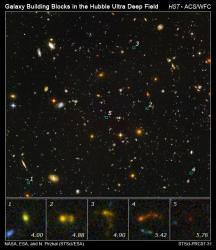Let’s go back, way back, to an earlier time when the Universe was a fraction of its current age. Tiny galaxies, just a fraction of the mass of the Milky Way came together, piece by piece, building up larger and larger galaxies. Well, we don’t have a time machine, but we’ve got the next best things: Hubble and Spitzer, which were called upon to look back into the distant Universe, to watch this process unfold.
The new data gathered by the Hubble Space Telescope and the Spitzer Space Telescope reveal a collection of the smallest, faintest, most compact galaxies ever seen. These aren’t the majestic spiral galaxies we know and love, but primordial building block galaxies that played an important role in the evolution of the structure of the Universe. The two great observatories saw these galaxies when they were just a billion years after the Big Bang; in other words, the galaxies are more than 12 billion light years away.
The images from Hubble are key. It saw galaxies that only contained blue stars just a few million years old. These young, hot stars haven’t had a previous generation before them. They’re using the pure raw material of the Big Bang – mostly hydrogen and helium – as their fuel, unpolluted by heavier elements. Spitzer came in after and helped make accurate measurements of the galaxies’ masses.
“These are among the lowest mass galaxies ever directly observed in the early universe,” says Nor Pirzkal of the Space Telescope Science Institute and the European Space Agency in Baltimore, Md.
Three of the galaxies look distorted, with the familiar tadpole shape of a galaxy in a gravitational tangle with another galaxy. And this is how it started. These tiny galaxies merged with one another, growing into larger and larger objects, and eventually spirals like our own Milky Way.
The earliest time of the Universe is gradually coming into focus, thanks to these observatories.
Original Source: Hubble News Release

